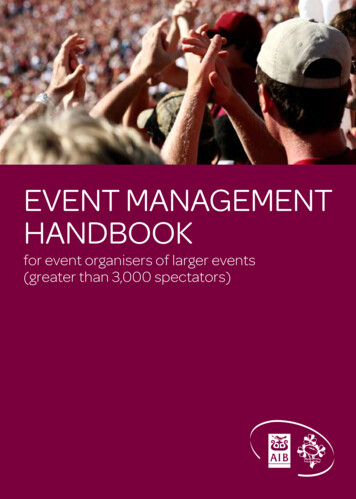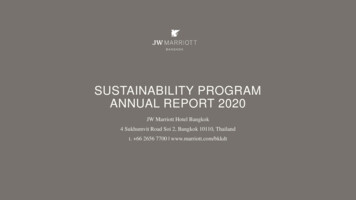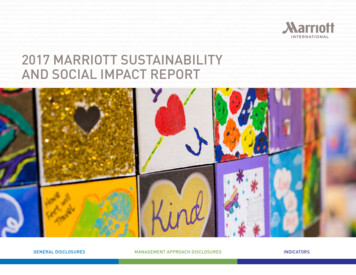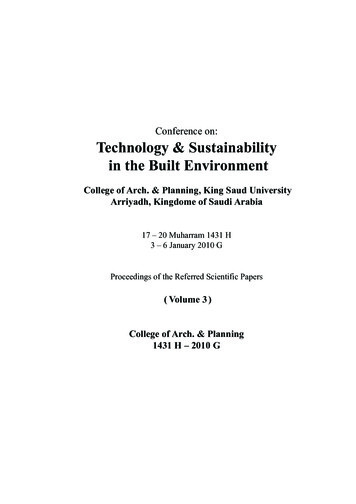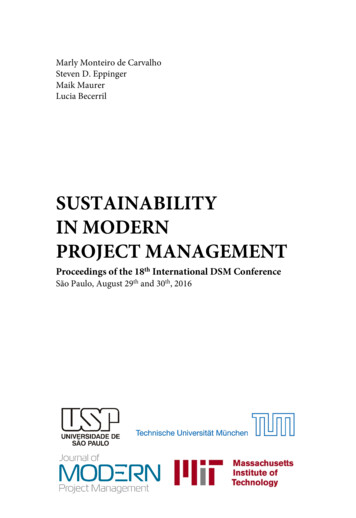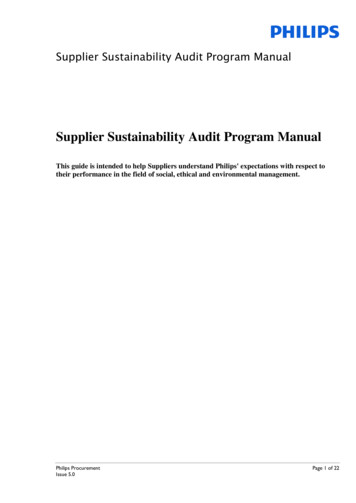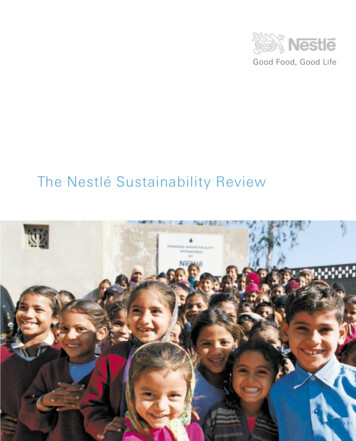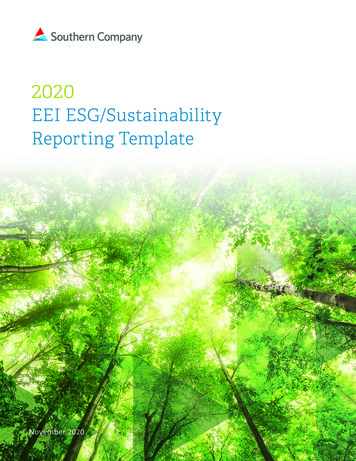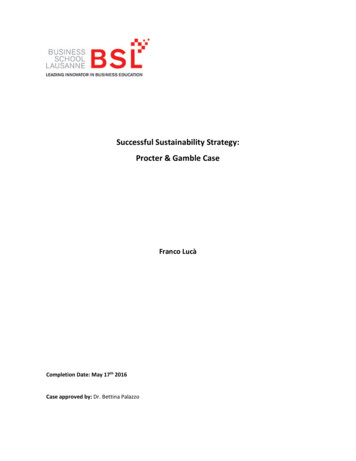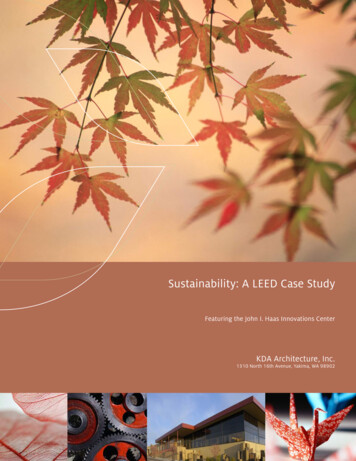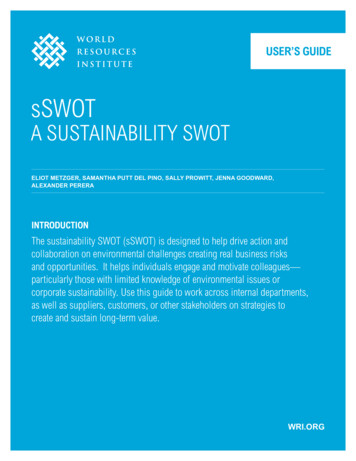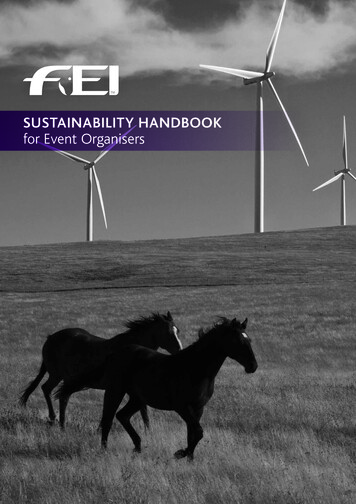
Transcription
SUSTAINABILITY HANDBOOKfor Event Organisers
CONTENTSFEI Presidents’s Message.05Sustainability Handbook introduction.06Create your own sustainability plan.09Event best practices checklists.15– Venue (infrastructure, stabling, overlay).17– Waste management.21– Energy use.23– Transport.25– Food & beverage, merchandising.27– On-site establishments.29– Management, communication and marketing.31– Accommodation (hotels, camping).33Acknowledgements/credits.35FEI SUSTAINABILITY HANDBOOK FOR EVENT ORGANISERS CONTENTS 3
FEI PRESIDENT’S MESSAGEThe concept of the FEI Sustainability Programme was born of our desire to makea serious contribution towards conserving the sound environment necessary for thepractice and continuity of equestrian sport.This handbook aims to encourage event organisers to implement various sustainabilityinitiatives that will help reduce negative environmental impact and createa positive legacy.Each initiative mentioned is linked to a ‘Sustainability Objective’ and is graded onits ‘Awareness Potential’, ‘Impact Minimisation’ and ‘Ease of Implementation’. Eventorganisers can select initiatives based on the priorities they have set themselves.The FEI Sustainability Handbook for Event Organisers will be made available onlineand we encourage your suggestions and feedback so that it can be developed furtherover time.Other FEI sustainability initiatives will follow, as we plan to create an interactive webplatform, knowledge database and diverse benchmarking tools. To develop these, theexpertise and experience within our community will be essential.The wide outreach and influence of sports events means that they can act as catalystsfor change within society and that gives us a responsibility we should all take veryseriously. With this handbook, we are making a small step towards a more responsiblefuture. There is a lot more we can do and we very much welcome your support innurturing sustainability across the global equestrian community.HRH Princess HayaFEI President4FEI SUSTAINABILITY HANDBOOK FOR EVENT ORGANISERS FEI PRESIDENT’S MESSAGE 5
SUSTAINABILITY HANDBOOKWhat is Sustainability?Where to beginSustainability means meeting the needs of thepresent generation without compromising theability for future generations to satisfy theirs. Developing a sustainable event requiresa methodical approach. First, you have to identifythe main areas/aspects of your event where youcan act, choose the sustainable objectives thatcorrespond to your priorities and select a fewinitiatives that you can implement. Progressively,you can adopt additional initiatives.Equestrianism is the only Olympic-level sportperformed in unison with an outstandingambassador of nature – the horse. It is ourresponsibility to do all that we can to conservethe sound environment necessary for the welfareof the horse and the sport itself.How will I benefit from adopting sustainability? Visibility & reputation– O rganising an event that is, insofar as possible,sustainable, highlights your commitment andleadership in conserving the environment.– I n doing so, it places your event in theworldwide sphere of responsible action.– B y using a local workforce and local suppliersyou trigger positive social inclusion, therebyenhancing your legacy Cost reduction (in the long term)– U sing less non-renewable energy, water,materials and minimising waste will reducecosts in the long run.6 The goal is not to achieve as many initiatives aspossible, but to be successful with theones selected. Regardless of the location and size of your event,the areas of application and the considerations arethe same: venue-related aspects, food & beverage,waste management, etc. Most of the initiativeslisted in this document apply to all events and itis possible to select and adopt some of them todevelop your sustainability efforts.How to identify priority areas and initiatives The handbook lists initiatives for each of theMain Domains of an equestrian event. To helpyou select appropriate initiatives, the handbookadds three parameters for each initiative, whichare graded ‘Low’, ‘Medium’, ‘High’ and ‘Very High’.These parameters are:– Impact Minimisation As soon as your sustainability goals have beendefined, they could be endorsed and supported byyour sponsor and other partners – from the firstplanning phases, through to the staging ofthe event. In this way, your event can offer a uniqueopportunity to showcase environmentally-friendlyproducts and services, while enhancing yoursponsor’s environmental profile. The biggest impact is made when yoursustainability goals and endeavours are promotedthroughout your sourcing chain, so that, whereverpossible, the products and services at your eventreflect the message that you want to convey.What to communicate and how Communicating your sustainability initiativesraises the profile of your event within thesport as well as with your stakeholders,including spectators. Both internal and externalcommunication needs to be incorporated fromthe planning stage. Internal communication inparticular should be well established so thatobjectives, rationale and protocols can beshared with your service providers. Engaging public authorities, volunteers, riders,spectators, and other stakeholders at and duringthe event is very important. For example, havinga well-known rider competing at your eventendorse your sustainability efforts in an interviewis an effective way of raising awareness. It mayalso inspire fans to adopt and follow what wassaid, thereby multiplying the effect considerably. Look for opportunities to build up yoursustainability targets by having a part contribution The FEI aims to create a dedicated Sustainabilityfrom each of your suppliers (venue infrastructurePortal that will offer a number of easilyprovider, caterer, etc).customisable communication tools. These will The FEI will also endeavour to partner withinclude templates with messages for spectators anda global environmental organisation. Thisfor advertising spots across the event city, videoswill provide you with a broad array of expertand “Green Event” banners. You may choose toinformation and tools to help you to implementtake the text and apply your own design or simplyyour sustainability initiatives in the most effectivejust insert your event and sponsor logos on theway. It will also contribute to the environmentaltemplates and use them in a way that best suitsquotient of your event as a whole.your communication strategy.– Awareness Potential– Ease of Implementation You can set your individual sustainability goalson the basis of a combination of the abovechoices and parameters. For example, your highestpriority may be ‘Impact Minimisation’ in ‘Food andBeverage’ or the ‘Ease of Implementation’ of aninitiative in managing waste. Alternatively, yourobjective may be a mix of them all. Henry Browne/Action Images/FEIStaging a sustainable event means that youpromote the use of resources in an efficient andresponsible way. Your actions reduce the negativeimpact of your event on the environment andcreate a positive social and economic impact.What are the benefits of engaging sponsorsand partners?FEI SUSTAINABILITY HANDBOOK FOR EVENT ORGANISERS SUSTAINABILITY HANDBOOK 7
CREATE YOUR OWN SUSTAINABILITY PLANWhat to consider while planning andallocating human resourcesHow to share experiences and learn from thoseof others Hire local staff who are familiar with the host city.You can also ask your vendors and suppliers toplan ahead and include as many locals as possible. The creation of a dedicated FEI SustainabilityPortal will provide you with a ‘Live KnowledgeBase’ of best practices, success stories andexamples of specific initiatives. Divide areas of function and specific sustainabilitytargets among the volunteers and organisemeetings with them before the event to explainyour sustainability initiatives.What does it cost? Organising a sustainable event does notnecessarily mean spending more money. Manyinitiatives are organisational measures that requireno extra costs, while some of them may evenreduce your expenses. On the other hand, depending on yoursustainability goals, some initiatives may requireinvestment in order to reap long-term benefits.For example, investing in waterless toilets orincorporating solar-panels in venue design willrequire upfront investments that you have toaccommodate in your budget. Over time, the ‘Live Knowledge Base’ on the FEISustainability Portal will request event organisersto voluntarily enter the costs related to theirinitiatives and describe the long-term benefitsthey derived from them. Other users will then beable to search for and refer to the relevant effortsand find out approximate associated costs. The ‘Live Knowledge Base’ will grow organicallythrough your commitment and sharing of yoursustainability implementation experiences. Itwill also serve as a forum through which you cancontact organisers whose successful sustainabilityefforts seem relevant to your event. Documenting and being transparent is alsocentral to measuring and learning from yoursustainability efforts. The FEI Sustainability Portalwill facilitate this by offering an online reportingand evaluation tool to create a ‘SustainabilityReport’ for your event. It will also include an easyto-use ‘Environmental Impact Calculator’ that iscustomised for equestrian events. Kit Houghton/FEI Create opportunities to involve the event hostcity’s senior citizens and youth as volunteers. Theyhave the potential, energy and passion to carryout your on-site sustainability initiatives duringthe event.How to gather feedback It is important to take into account the views andexperiences of all groups of people involved in thesuccessful staging of the event.Create your own Sustainability Implementation Plan The FEI Sustainability Portal will offer youdifferent types of feedback collection mechanismsand forms that can be customised with your ownlogo and branding. You will be able to use these tocollect feedback from your suppliers, volunteers,spectators and also document it on the ‘LiveKnowledge Base’.Each ‘ 1 Sustainability Initiative’ is linked to one of 18 ‘Objectives’.And each ‘ 2 Objective’ is linked to one of eight ‘ 3 Main Domains’. Feedback is as important as measuring andreporting and provides you with the real world’sview on the extent of your success in yoursustainability efforts.We have compiled a list of more than 150 ‘Sustainability Initiatives’. This section willhelp you select those that you would like to implement at your event.1The action to be executed2 The overall aim that implementing a certain Sustainability Initiative will accomplish3 The area and aspect of your event across which Sustainability efforts can be madeThe table on pages 10 and 11 shows each of the Objectives and Main Domains.A ‘ ’ highlights which Objective is relevant to which Main Domain. It implies that thereare one or more Sustainability Initiatives possible for that combination of Objective andMain Domain.An empty box (where there is no ‘ ’) indicates that the Objective and Main Domain arenot relevant to each other and that there is no recommended Sustainability Initiative.8FEI SUSTAINABILITY HANDBOOK FOR EVENT ORGANISERS CREATE YOUR OWN SUSTAINABILITY PLAN 9
MAIN DOMAINSOBJECTIVESVENUE (infrastructure,stabling, overlay)WASTE MANAGEMENTENERGY USETRANSPORTFOOD & ENT,COMMUNICATION,MARKETINGACCOMMODATION(hotels, camping)Encourage waste sortingand recyclingMinimise the production of wasteExtend the use of material andproducts (rent, re-use, store froma year to the next, etc.)Save waterManage and treat waste waterMinimise the use of nonrenewable energiesProduce (onsite) renewable energyOptimise or reduce personneltransport (plane, cars, etc.)Optimise or reduce freight transport(plane, trucks, etc.)Favour walking, biking and the useof public transportationOffset your carbon emissionsUse existing building, facilities andmaterialPreserve the natural habitat of theevent location and surroundingsUse sustainable products (locallyproduced, recycled, renewable,certified, non-toxic, etc.)Benefit from external expertiseFinance your sustainability policyInvolve, share and raise awarenessOrganise and coordinate thesustainability effort10FEI SUSTAINABILITY HANDBOOK FOR EVENT ORGANISERS CREATE YOUR OWN SUSTAINABILITY PLAN 11
CREATE YOUR OWN SUSTAINABILITY PLANIn order to create your own Sustainability Plan, we recommend that you take thefollowing steps:1A step-by-step example1Jamie (an Event Organiser) looks at the table on pages 10 and 11 and is interested in ‘Waste Management’and ‘Energy Use’ ( Main Domains)From the eight Main Domains listed on pages 10 and 11, shortlist those you wishto concentrate on.2As indicated by the ‘ ’, one or more Objectives will be relevant to the MainDomains you have shortlisted. You can choose to adopt all or some of those.WASTEMANAGEMENT2He finds that
Create your own sustainability plan. 09 Event best practices checklists . MARKETING ACCOMMODATION (hotels, camping) Encourage waste sorting and recycling Minimise the production of waste Extend the use of material and products (rent, re-use, store from a year to the next, etc.) Save water Manage and treat waste water Minimise the use of non- renewable energies Produce (onsite)
